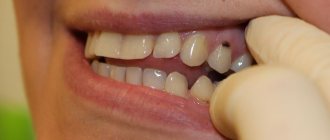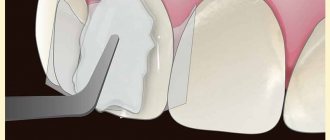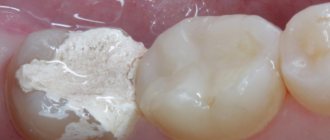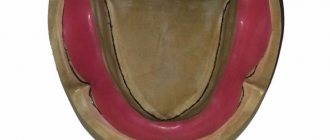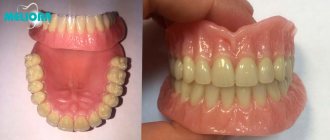Advantages of photopolymer materials
Disadvantages of photopolymer materials
Types of photopolymer materials
Installation of a polymer filling
Photopolymer fillings are very popular today due to their unique qualities. They allow the dentist to create the highest class restorations right in the patient’s mouth, which, with a good level of doctor skill, are in no way inferior to natural teeth. Due to their ability to harden under ultraviolet rays, the dentist has plenty of time to model the chewing anatomy of the teeth.
What is a photopolymer filling?
Photopolymer filling is a popular and convenient way to restore teeth, which uses photopolymer materials.
Composites harden in the oral cavity solely under the influence of a specific wave of light emanating from a lamp. Thanks to this property, the dentist can do his work slowly and creatively.
In addition, light-reflecting composites are available in different colors and degrees of transparency, and accordingly, with their help it is possible to hide darkened hard tissues and even metal, as well as restore enamel and dentin.
There is also technology that allows you to combine reflective and chemical materials. It is in this case that it is possible to make the most of all the advantages and neutralize the disadvantages of each method.
There are many reasons why photopolymer fillings are widely used in dentistry. The risk of cracks occurring during operation is minimized. All functions of the teeth are completely restored, while the patient’s sensations remain the same as with healthy teeth.
Why everyone wants only photocomposite fillings: advantages of the material
Even conservative patients understand which filling is better - photopolymer or conventional. The popularity of composites is explained by the following advantages:
- Quick installation. Crowns or veneers are not placed immediately. You need to visit the doctor several times. Photopolymers are made immediately in the office and installed in one step.
- Minimal dental preparation. The use of these composites does not require preparation. They can be installed even on chipped surfaces due to the plasticity of the material.
- Density and strength. Using photopolymers, an ideal surface is created. After treatment, you can chew any food, including hard vegetables, fruits, nuts, caramel, etc. You can eat an hour after filling.
- High aesthetic qualities. Thanks to the rich palette of shades, the doctor will select or mix the most suitable color option. The restored tooth looks like a natural one.
- Safety. The composition is hypoallergenic and does not emit toxic substances. These are the undoubted advantages of the material, which allow it to be used in pediatric dentistry.
- Optimal price-quality ratio. This method of treatment is available to patients of different age categories, although it is more expensive than fillings made from amalgam or cement. And the installation speed and service life will please everyone.
How else is the material different? It does not cause side effects, adheres well to enamel and dentin, does not affect the internal structure of the tooth and does not interfere with its functionality. According to patient reviews, there is an insignificant difference between the filling and the enamel, but it does not interfere with speaking, biting and chewing.
When it comes to dental restoration, there is no better material to look for than photopolymers. The material is also indispensable for teeth performing the chewing function. Since they bear a lot of load, high-strength composites will be very useful.
Kinds
Regardless of the type, a composite material is used to make a photopolymer filling. He can be:
- macro-filled;
- microfilled;
- minifilled;
- hybrid;
- compomer.
In addition, composites are divided into fluid and solid. They are placed in syringes and applied to the surface to be treated using tools specially designed for this purpose. Conventional ones are not suitable for this purpose, as the material will stick to them.
In case of restoration of the interdental contact point, as well as when filling the cervical area, they resort to the use of fluid polymer fillings.
It is they that fit as tightly as possible and are evenly distributed over the surface, due to which they create tight contact with hard tissues. They are easy to use. In this case, the possibility of applying more composite than necessary is completely excluded.
Let's find out why a tooth hurts after a temporary filling
In the process of restoration of anterior teeth, it is customary to use solid photopolymers. They are plastic, thanks to which they can give the tooth any shape and will fully correspond to the anatomical structure.
When restoring a large cavity, the material is applied in layers, since the rays of the lamp cannot penetrate into the deep layers. For more reliable fixation, the enamel is highlighted first and only then the remaining areas.
Photopolymer restoration: features
Light-curing materials in dentistry have a high coefficient of adhesion, practically do not shrink and can withstand heavy loads. Therefore, dental restoration with photopolymers is suitable for almost all teeth. Dentists perform:
- Photopolymer restoration of anterior teeth;
- Teeth extension with photopolymers;
- Filling of chewing and front teeth with photopolymers.
In recent years, a new photopolymer has been developed that has a nanohybrid structure. Fillings made from this composition have a high strength coefficient, and at the same time they are plastic. Thus, restoration of anterior teeth with photopolymer can be implemented even on microscopic cavities, where traditional material cannot hold.
Another advantage of the new method: during installation of a light-curing filling, only the top layers damaged by caries are removed from the tooth. That is, there is no need to drill and injure the tissue once again.
Large fillings are called microprostheses; they correct the appearance, while it is possible to form any shape of the tooth.
Photopolymer dental restoration helps solve many problems of the oral cavity, which is why it is actively developing and is very popular in recent years. At the same time, the price of photopolymer for teeth remains in the average marketing segment. We follow the development of the industry and offer our clients the latest technologies and materials in the dental market. With us you will receive modern treatment at the highest level.
Indications and contraindications
There are a number of indications for which the use of photopolymer materials is used. The main ones:
- tooth fracture;
- change in color of enamel that cannot be bleached:
- significant defects of tooth enamel;
- the presence of large fillings in the cervical area;
- noticeable interdental gaps;
- the need for minor correction of the position of the teeth;
- damage to the crown by a maximum of forty percent.
Even if there are indications for installing a filling, a specialist may refuse to carry out the necessary treatment. Among the main contraindications for installation are the following:
- bruxism;
- severe destruction of the front teeth;
- active development of caries;
- teeth subjected to intensive fluoride treatment;
- lack of proper oral hygiene.
Some of the contraindications are classified as conditional. Over time, they can be eliminated, and, accordingly, there will no longer be barriers to installing fillings made of photopolymer materials.
Installation
The process of installing a photopolymer filling is carried out in several stages. Most often, treatment is carried out according to this plan:
- Administration anesthetic drug.
- Preparation of the area affected by caries.
- Treatment with medications.
- Isolation of saliva and mandatory drying.
- Application of acid to improve adhesion.
- Thorough rinsing and drying.
- Application of adhesive material.
- Layer-by-layer application of the composite.
- Polishing and grinding.
If the depth of the lesion is too great, then additionally resort to the use of a therapeutic and insulating pad. If dentin layers are damaged, they must be isolated. In those cases when the cavity is excessively large, first a medicinal material is placed into it and only then an insulating material.
The process of etching the enamel can be carried out both before and after insulation. The gel, which contains orthophosphoric acid, is applied exclusively to the dried surface. Only in this case will it be possible to achieve the desired effect.
After applying the adhesive system, it is sprayed using an air stream. Then the material is illuminated with a lamp for literally half a minute. The filling is formed by layer-by-layer application of reflective material.
At the final stage of installation, the filling is ground, removing all irregularities and polished. The tooth acquires natural smoothness and shine. It is almost impossible to distinguish it from natural one.
How does filling the front teeth differ from the rest?
In general, fillings for the front teeth are done in the same way as for all the others. Sometimes there is not even a need to resort to anesthesia. The only difference is the aesthetics of the fillings. The smile zone requires fillings on the front teeth to be as close as possible to the structure of the natural tooth. Therefore, most fillings that are installed on the front teeth are made of modern composite materials of the latest generation, that is, they are installed by layer-by-layer application (stratification technique).
Care
The rules for caring for photopolymer fillings are practically no different from ordinary oral hygiene.
Patients simply need to brush their teeth regularly with a soft toothbrush and rinse their mouth with warm water or a special solution after each meal.
It is also important to regularly, at least once every six months, have a routine examination with a dentist. Only if problems are detected in a timely manner can they be easily eliminated and the development of more serious diseases prevented, and accordingly preserve the integrity of the tooth that has been restored.
Life time
The service life of photopolymer fillings largely depends on the quality of the material and the competence of the specialist. In addition, the patient himself is able to both shorten and significantly extend the service life of the filling.
The materials used in the filling process can be either highly durable or less reliable. Provided that a high-quality composite is used, it can last up to seven years.
There are cases when the filling falls out almost immediately after its installation. There may be several reasons for this. It is possible that when filling, the doctor made a mistake, as a result of which the material was not securely fixed. The most common cause is adhesion failure due to saliva or liquid.
Find out why a tooth hurts after filling
In such cases a guarantee is issued. Within a year after the filling is installed, the patient can apply for a repeat procedure. There is no charge for the service.
It is also possible that the patient simply did not follow all medical recommendations. In this case, you also need to seek help from a specialist. It is advisable to give preference to those clinics that have only positive recommendations. In this case, the risk of the filling falling out will be minimal.
Do's and don'ts after installation
When installing light fillings, the doctor gives a number of recommendations, following which it is possible to preserve their integrity for many years. The most important of them are the following:
- Eliminate viscous foods from the diet that can lead to loss of the composite.
- Avoid excessively hard foods such as nuts and crackers, especially in cases where the front teeth have been restored.
- Get rid of the habit of biting your nails and biting threads.
- Brush regularly, at least twice a day .
- professionally once every six months . In this case, be sure to inform the specialist that photopolymer fillings have been installed and indicate their exact location.
- For several days after the filling is installed, do not eat foods that contain dyes. Otherwise, the material will darken and the tooth will lose its natural appearance.
The main advantage of fillings made from photopolymer materials is that you can eat food immediately after the procedure. If chemicals are used, it is necessary to wait at least two hours for the cement to completely harden.
Advantages and disadvantages
The demand for photopolymer fillings is due to a number of their advantages. The main ones are the following:
- it is possible to accurately restore the relief and shape of teeth even in cases where they are too damaged;
- the filling is combined with hard tissue into a single whole thanks to a special adhesive system;
- after hardening, the material becomes durable, securely bonded to the enamel, and resistant to cracking;
- it is possible to achieve the desired cosmetic effect by selecting the desired color shade of the material;
- installation is carried out by applying the composite layer by layer, thereby creating an imitation of natural dental tissues;
- preparation of cavities and defects is reduced to a minimum;
- In case of delamination or chipping, adhesive correction is possible.
Among the disadvantages of such fillings, one can highlight only shrinkage of the composite when exposed to light and insufficient polymerization. The polymer does not harden completely, and therefore the original shade may change over time.
Photopolymer fillings have many advantages, which is why they are most often used in dentistry. This is a reliable type of dental restoration, with the help of which it is possible to give even severely damaged hard tissues a natural appearance.
Another peculiarity of the use of light composites is that the material hardens only under the influence of a special lamp. Accordingly, the specialist has the opportunity to clearly recreate the natural shape of the tooth, which is very difficult when using other materials.
What is a light or reflective seal?
So, a light filling (photopolymer, light-polymer, reflective, polymer, light-hardening, etc.) is considered one of the highest quality and most durable materials. However, its main advantage is its high aesthetics. It is almost invisible on the teeth and can be used to correct the frontal area.
Many people ask the question: “What is the difference between a light filling and a regular one?” In fact, the main difference between these two materials is the speed of hardening. For example, if a photopolymer filling hardens under the influence of ultraviolet radiation within a few seconds, then in order for the chemical material to acquire the necessary hardness, you need to wait 2 hours until its components react. That is why a light-curing filling or light-curing filling is optimal for high-quality and aesthetic dental restoration.
The most important advantage of a light filling is the variety of its color tones. This allows you to select the exact color that fully matches the natural shade of the patient’s tooth enamel in each individual case.
[]




